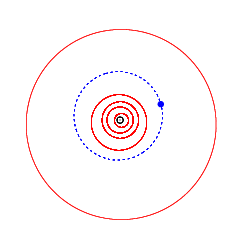9930 Billburrows
|
| |||||||||||||
| Discovery | |||||||||||||
|---|---|---|---|---|---|---|---|---|---|---|---|---|---|
| Discovered by | E. Bowell | ||||||||||||
| Discovery date | 5 February 1984 | ||||||||||||
| Designations | |||||||||||||
| MPC designation | 9930 Billburrows | ||||||||||||
| 1984 CP, 1961 CO, 1961 EF, 1980 BB6 | |||||||||||||
| Orbital characteristics[1] | |||||||||||||
| Epoch 13 January 2016 (JD 2457400.5) | |||||||||||||
| Uncertainty parameter 0 | |||||||||||||
| Observation arc | 23844 days (65.28 yr) | ||||||||||||
| Aphelion | 2.6891492 AU (402.29099 Gm) | ||||||||||||
| Perihelion | 2.1848325 AU (326.84629 Gm) | ||||||||||||
| 2.4369908 AU (364.56863 Gm) | |||||||||||||
| Eccentricity | 0.1034712 | ||||||||||||
| 3.80 yr (1389.6 d) | |||||||||||||
| 96.055313° | |||||||||||||
| 0° 15m 32.665s / day | |||||||||||||
| Inclination | 7.459058° | ||||||||||||
| 125.39089° | |||||||||||||
| 77.859469° | |||||||||||||
| Earth MOID | 1.19618 AU (178.946 Gm) | ||||||||||||
| Jupiter MOID | 2.29875 AU (343.888 Gm) | ||||||||||||
| Jupiter Tisserand parameter | 3.485 | ||||||||||||
| Physical characteristics | |||||||||||||
| Dimensions | ~12.9 km[2] | ||||||||||||
| ~0.01 | |||||||||||||
| |||||||||||||
| C-type asteroid[3] | |||||||||||||
| 13.8 | |||||||||||||
|
| |||||||||||||
9930 Billburrows is a C-type main belt asteroid. It orbits the Sun once every 3.80 years.[1]
Discovered on February 5, 1984 by Ted Bowell working at the Anderson Mesa Station of the Lowell Observatory, it was given the provisional designation "1984 CP". It was later renamed "Billburrows" after William E. Burrows, a professor at New York University who founded the Science, Health and Environmental Reporting school there.[4] The name was suggested by E. M. Standish.[5]
References
- 1 2 "9930 Billburrows (1984 CP)". JPL Small-Body Database. NASA/Jet Propulsion Laboratory. Retrieved 13 April 2016.
- ↑ Tedesco E.F.; Noah P.V.; Noah M.; Price S.D. "The supplemental IRAS minor planet survey (SIMPS)".
- ↑ Gianluca Masi; Sergio Foglia & Richard P. Binzel. "Search for Unusual Spectroscopic Candidates Among 40313 minor planets from the 3rd Release of the Sloan Digital Sky Survey Moving Object Catalog".
- ↑ "Journalism at NYU - Science, Health and Environmental Reporting". New York University.
- ↑ MPC 43043 Minor Planet Center
External links
This article is issued from Wikipedia - version of the 9/10/2016. The text is available under the Creative Commons Attribution/Share Alike but additional terms may apply for the media files.
